Introduction
Our third multi-session course ‘The Secret Life of the Human Brain’ is now well underway and is proving a fascinating account of this remarkable organ. Our next event will be the AGM on 24th June. Although there will be a reminder in the next edition of FORUM, we urge you to put the date in your diary now. The business part of the meeting will be followed by a talk by Jill Newsham on ‘Modern Art for the Table and the Harrods Exhibition of 1934’.
We will soon be publicising next year’s programme and arrangements for renewing membership.
We have two contrasting articles in this edition. Christine Vasey tempts our taste buds with the joys of Vienna, and Roger Mitchell reflects on an American President whose influence on the post Second World War world was of great significance. We also supply answers to last month’s quiz.
Annual General Meeting
Friday 4th June
An Annual General meeting is important and necessary for any organisation, but we intend to keep ours brief, while maintaining a business-like approach. We have also coupled it with a talk, so the meeting will offer more than just administration. We will have a report on the Society’s progress, approve financial accounts and elect officers and a committee. You will receive formal notice of this meeting in due course.
Scarisbrick Hall Visit
We are pleased to be able to inform you that Mary Ormsby has arranged for SUES members to visit Scarisbrick Hall. These visits will take place on Wednesday 3rd August and Thursday 4th August. Numbers will be limited and once the details have been confirmed, an email (or letter) will be sent to all members to book places on the tours.
Forthcoming Friday Meeting: Art and Industry – Modern Art for the Table – The Harrods Exhibition 1934
Friday 24th June at 2:30pm at All Saints Church Hall
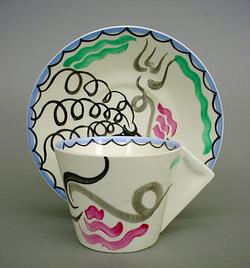
The next Friday talk will be by one of own members, Jill Newsham on the subject of Art and Industry in the 20th Century with particular reference to the Harrods Exhibition of 1934. The relationship between Art and Industry has long been debated and the years between the wars were a dynamic time for British ceramic and glass design. The Harrods exhibition brought together famous artists and manufacturers in calibration for the first time on Britain’s High St. Jill will illustrate her talk with actual pieces from the exhibition.
Vienna: Culture and Coffee
In 2018, a visitor to the Uffizi Gallery in Florence had a heart attack whilst standing transfixed in front of Botticelli’s famous masterpiece, The Birth of Venus. Was this unfortunate tourist suffering from a heart condition or perhaps from an extreme case of Stendhal’s Syndrome? For those of you who have never before come across this strange psychosomatic condition, a brief explanation follows.
This affliction was first described by the French novelist, Stendhal, when in 1817, he visited Florence and was so emotionally overcome by the overwhelming beauty of the city and its magnificent art treasures that he experienced palpitations, fainting fits and hallucinations. He called it ‘Florence Syndrome’ but as, subsequently, many other people reported experiencing similar symptoms in a variety of different locations, it has become known as Stendhal’s Syndrome.
History does not report whether Stendhal ever visited Vienna but it goes without saying that the sublime beauty of this amazing city could undoubtedly cause many a sensitive soul to quail and feel faint, but unlike other cities of rare artistry Vienna has an antidote to aesthetic overload which we will explore at some length. So, delicate flowers, you can approach the Austrian capital in confidence, knowing that no matter how much sublimity you are exposed to, you will not end up in hospital!
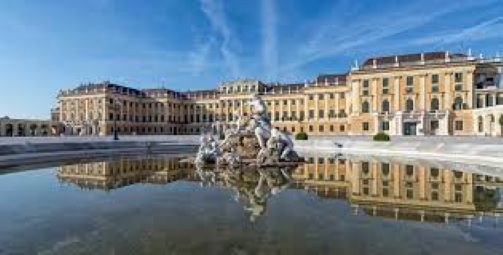
Vienna offers the discerning culture vulture a veritable feast of delights, and palaces are a good place to start. As the capital city of the former Austro-Hungarian empire, Vienna has more than its fair share of royal residences. Not to be missed are the Schonbrunn and the Belvedere. The overpoweringly magnificent exteriors and interiors of these gilded Hapsburg dwellings relegate Buckingham Palace to the level of a modest country house ! However, there comes a point when one has had rather too much of grandeur and all that gold leaf, porcelain and silverware, so how about a quick whirl round the Albertina Art Gallery to marvel at Klimt’s golden paintings? Egon Schille, Oska Kokoscka and other Viennese Secessionist artists, who dominated the cultural landscape prior to 1914, are also on display there. If it’s Old Masters you’re after, head for the Kunsthishtorisches Museum. Rembrandt, here we come!
You’ve ticked off palaces and paintings, but still a couple of hours to go before lunch. Time for something completely different! The Lipizzaner stallions at the Spanish Riding School trained in Haute Ecole classical equitation dating back 450 years would add variety to your list of must-dos. You cannot fail to be impressed by the immaculate display of horsemanship produced by these amazing animals and their traditionally costumed riders and at least you can sit down for a bit.
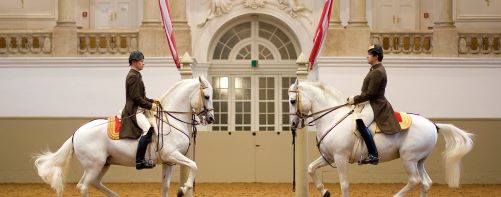
You might just be able to squeeze in a quick look at the Stephansdom (St. Stephen’s cathedral) right in the city centre. A real architectural gem! This symbol of Vienna was founded in 1137 and badly bombed in the Second World War. Its brilliantly coloured, ornately patterned tiled roof has been fully restored to its medieval glory. If churches hit the spot for you, this one is a winner!
Of course, you will have been savvy enough to have made arrangements for your evening. You know that Vienna has more composers than you can shake a stick at: Mozart, Beethoven, Hayden, Schubert, Brahms, Strauss (the whole family) to name but a few and, undoubtedly, you wish to pay homage to this superfluity of musical genius, so you’re either going to the Opera House in the Ringstrasse to catch Beethoven’s Fidelio or you’ve booked tickets for whatever delights the Vienna Philharmonic has on offer.
But, at this very moment, after a morning of the non-stop sightseeing, cultural burnout is sweeping over you. You think longingly of the simple pleasure of sitting in your own back garden where, mercifully, the bling of high Baroque is noticeably absent. You may have experienced a few twinges of Stendhal’s Syndrome during the morning but it is the lesser complaints of angst and exhaustion that have really got you in their grip. Do not despair! Help is at hand! The great city of Vienna provides solace and restorative calm to the overwrought traveller in the form of the world-famous Viennese coffee houses. These delightful establishments are to be found all over the city. Elegant décor, tiny marble-topped tables, newspapers hanging on wooden rods, waiters in formal white shirt, black tie and floor-length apron bringing you a melange (espresso with steamed milk) on a silver salver, together with a glass of water and a plate with a slice of the most delicious cake you have ever eaten. Although mobile phones are not actually banned, taking a selfie at this point might be considered de trop in such hallowed surroundings. With the first bite of sachertorte, the confection on your plate, you are in cake heaven and all the strains and stresses of the morning will disappear.
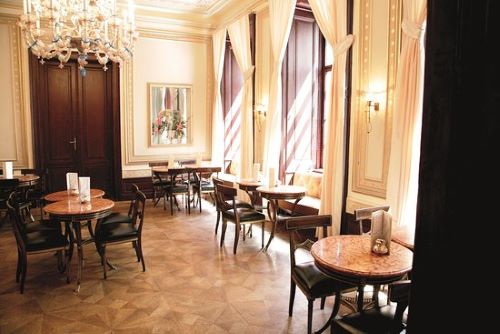
As you linger for hours in one of these charming venues, just relaxing and watching the world go by, equilibrium restored, you might be surprised to learn that the therapeutic serenity you are experiencing is underpinned by a bitter rivalry which existed between the confectioners of Vienna for almost 200 years.
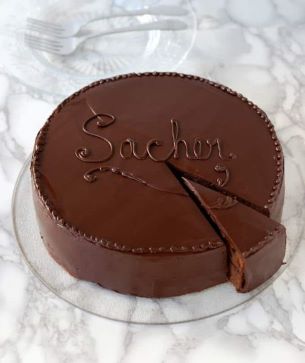
It all started in 1832 when Prince Metternich asked his head chef to produce a new dessert in honour of some distinguished guests. The chef was taken ill and the task then fell to a 16-year-old pastry apprentice called Franz Sacher. Seizing the opportunity to shine, Franz created a chocolate sponge cake soaked in apricot jam, covered in chocolate icing and served mit schlag (with whipped cream) as it still is today. Sacher named the cake after himself and his recipe has ever since remained a closely-guarded secret. Sacher went on to found his own famous hotel and coffee shop.
However, jealous rivals claimed it was they who were the only begetters of the famous chocolate cake and the ensuing cake wars raged for many years. Sacher’s most vociferous opponent was Herr Demel who set up a coffee shop in 1793. Prior to that, he had been the emperor’s confectioner. He claimed that Sacher had worked under him in a junior capacity and the ‘so-called’ sachertorte was created under Demel’s auspices in the imperial kitchens. The legal wrangle that ensued was finally settled in 1963 when the courts ruled in favour of the Sacher organisation, which was given the exclusive right to market their confection as the ‘Original sachertorte.’ Demel had to be content with ‘Demel sachertorte.’
Another pretender to the original torte crown is the Imperial Hotel in Vienna which nowadays, just like Sacher and Demel, sell their cakes online. The Imperial also had a myth and a chef to give credence to their claim. In 1873, the hotel was honoured by a visit from Emperor Franz Josef and once more, a junior member of the kitchen staff came up with a very special confection. Xavier Loibner crept into the kitchen in the middle of the night when all his colleagues were asleep and invented a chocolate cake made up of layers of hazelnut waffles filled with chocolate cream, enveloped in marzipan and topped with chocolate icing. The emperor was duly impressed and the legend of the Imperial torte was born.
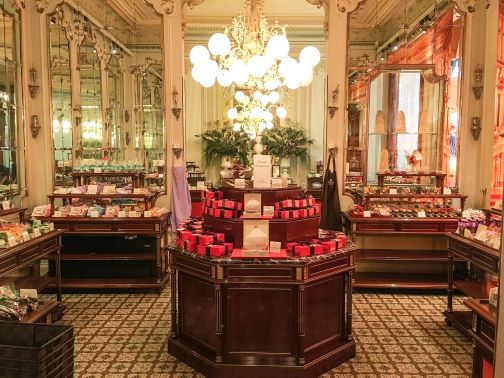
You have now experienced the healing powers of the coffee houses and, as a result, your stay in Vienna will be much less fraught from now on. You will start your day in a coffee house and think unhurriedly about what to do and see. Maybe a cruise along the Danube. Can it really be blue? Probably not but at least there will be good coffee on board. You might pop in to the Hofburg Palace, the home of the Empress Elizabeth, known as Empress Sisi. So beautiful and so popular with the ordinary people! Strange to say, Princess Diana’s life had many uncanny parallels to the life of the Empress who married Emperor Franz Josef at the age of 16 and hated the stuffy formality of the imperial court. She eventually escaped by spending most of her time in Budapest. Sadly, she was assassinated by an Italian anarchist in Geneva in 1898 and the whole empire mourned her loss.
On a more cheerful note, why not try a lunchtime concert? You can usually catch a bit of Mozart at the beautiful Baroque church of St Charles or maybe St Anne’s and certainly at St Peter’s. Then another slice of coffee shop therapy. You could go to Demel’s and decide if the Demel sachertorte is more to your liking than the Original sachertorte. This is going to take a very long time but you will emerge, possibly, singing under your breath the Billy Joel song ‘Vienna Waits for you’, probably, a few pounds heavier and definitely, happy and contented, at peace with yourself and the world.
Lord, if there is a heartache Vienna cannot cure, I have never felt it. I came home cured of everything except Vienna.
Storm Jameson
Christine Vasey
The Buck Stops Here – The Toughest Job in the World?
Forty five men have held the post of President of the United States, but Joe Biden is officially described as the 46th President because Grover Cleveland served two separate terms (1885–1889 and 1893-1897). The White House website has paintings or photographs of them all and it is interesting to note that until 1960, every President is solemn and unsmiling, whereas from John F Kennedy onwards, all of them, with the possible exception of Lyndon Johnson, have a cheerful smile for the camera.
Perhaps that is how they hope to be remembered, because they all know that they will be judged both by their contemporaries and by history, or rather by historians. Ever since 1948, American academics have enjoyed putting the Presidents into an order of merit. The Wikipedia article entitled ‘Rating the Presidents’ gives the full details including the qualities by which they have been judged. In the past, these have included everything from intelligence to imagination, from willingness to take risks to ability to compromise and have included both integrity and luck. The most recent survey was published in 2021, when 142 historians and commentators rated all Presidents on a scale of 1-10 for each of ten leadership characteristics. The top ten Presidents and their points score out of 1,000 was as follows.
| Abraham Lincoln | 897 |
| George Washington | 851 |
| Franklin Roosevelt | 841 |
| Theodore Roosevelt | 785 |
| Dwight Eisenhower | 734 |
| Harry Truman | 713 |
| Thomas Jefferson | 704 |
| John Kennedy | 699 |
| Ronald Reagan | 681 |
| Barack Obama | 664 |
Judgements on recent Presidents often take some time to settle, but even so, Donald Trump with 312 points has some way to go, even though he finished ahead of Franklin Pierce, Andrew Johnson and at the very bottom James Buchanan with 227 points. It is only a game, of course, but it is not without interest and it raises all sorts of issues. The top three Presidents served at times of great crisis; for Washington, it was the creation of the Union, for Lincoln the Civil War and for Roosevelt both the Great Depression and World War Two. Five of the top eight Presidents were elected between 1900 and 1960, whereas in the 100 years between the elections of Thomas Jefferson and Theodore Roosevelt, Abraham Lincoln was the only top 10 President.
I want to examine just one of the top 10 and he is perhaps the most unexpected figure to appear there. Harry Truman was not a renowned war leader like Washington and Eisenhower, nor was he a member of the elite, like Jefferson or the Roosevelts. He lacked the charisma of Kennedy, Reagan and Obama and, like Lincoln, he was an outsider from relatively humble origins. Lincoln and Truman both had a modest formal education, but both were great readers. They came to the Presidency from relative obscurity, untested and with limited political experience. The decisions that they had to make were literally matters of life and death, war and peace. In four one syllable words, the sign on Truman’s desk said it all – ‘The Buck Stops Here’.
Lincoln is the more heroic figure and he has entered the public imagination to a much greater degree than Truman. He appears on the one cent coin and the five dollar bill, his memorial in Washington DC is on a heroic scale and his life has been dramatized for film and television. Truman, who died as recently as 1972, is less well known but his reputation remains high, helped perhaps by an outstanding biography published in 1992. In 992 pages plus a hundred more giving sources, the distinguished American historian, David McCullough, has analysed both the man and his times. It is an exceptional biography and I found it both instructive and enjoyable.
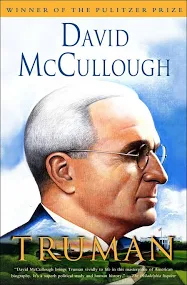
The life that it describes was a remarkable one, but for the first 200 pages of the book and the first 50 years of Truman’s life, there is little to suggest that he would become a major figure on the national and international stage. He had been successful in a modest sort of way in his home state of Missouri. As a young man he had run the family farm. He had volunteered for service in World War One. He went to France as a Captain in the Artillery, fought on the front line and came home, still a Captain. He married his childhood sweetheart and set up a haberdashery store in Independence, Missouri. After initial success, this failed in 1922, but he eventually cleared his debts, largely because he went into local politics as a Democrat. He was elected with the title of Judge but his job in Jackson County was administrative rather than judicial. He proved efficient and honest, although he owed his election to the powerful Prendergast family who were prominent in Missouri politics. It was as their candidate that in 1934 he was elected as junior senator for Missouri and went off to Washington. Drawing on his administrative efficiency he chaired a committee looking at money wasted in government contracts and gained some national notice, particularly after America entered the war. When Roosevelt sought a fourth term in 1944, Truman seemed a safe choice as his running mate. He balanced the ticket, had relatively few enemies and could be trusted to behave himself. Had Roosevelt completed his term, Truman might have joined that list of forgotten vice-presidents. However, Roosevelt died suddenly, but not entirely unexpectedly, and after only three months as Vice President, Truman became the 33rd President. In 1948 to many people’s surprise, but not his own, he won a second term and remained in office until January 1953.
In those eight years, he played a major part in reshaping the world and creating a fragile stability that lasted for almost half a century. In his first year, he accepted the German surrender, negotiated with Stalin and Churchill at Potsdam and authorised the dropping of the atomic bombs on Hiroshima and Nagasaki which brought about the Japanese surrender. He did not just end the war, he played a major role in creating the post war world. America did not retreat to isolation but took the leading role in both Europe and Asia. The United Nations and NATO were created. The Marshall Plan, named after his Secretary of State, enabled Europe to recover more quickly than had been expected. The Truman Doctrine made it clear that America’s top priority was the containment of the Soviet Union. Truman faced a number of extremely dangerous international crises and responded with general good sense. He supported the Berlin Airlift and United Nations action in Korea, he had an able and supportive cabinet to give advice but he was always clear that it was the President who took decisions and when General MacArthur, the commander of the American forces in Korea, seemed less than supportive, Truman relieved him of his command.
Not all his policies were successful and inevitably he was much criticised by his political opponents and by the press. He was not particularly popular with the electorate. His election victory in 1948 was a narrow one and he recognised that if he had stood for re-election in 1952, he would probably have lost. Instead, he went back home, wrote his memoirs and supervised the creation of his presidential library. He provided support for democrat candidates like Kennedy in 1960 but, essentially, he resumed his old life, living in his old house in Independence, Missouri, and walking around the town, without any security. He enjoyed 20 years of retirement and died at the age of 88.
Truman was always conscious that his actions were being watched and his decisions assessed. He was not the first President to write a memoir including his time in office; Grant, Coolidge and Hoover had all done this. However, Truman was perhaps the first who did so primarily to define his time in office for posterity. Every President after Truman, with the exception of John F Kennedy has followed the tradition that he started. He also kept a diary and wrote thousands of letters to his wife, his mother, his sister and his cousins as well as to army friends and political associates. Many are about day to day practicalities but politics and decision making inevitably find their way in. Historians have plenty of material to assess the man and his Presidency and in the acknowledgements at the end of his biography, David McCullough begins by thanking Truman for his ‘candid and revealing account’ and for doing so in such a clear hand.
I think that Truman was being honest and confirming his basic decency and humility when he wrote, ‘Do your duty and history will do you justice’. Sixth place in the rating of 45 Presidents is a fair judgement for the outsider and late developer from Independence, Missouri.
Roger Mitchell
SUES Quiz Answers
- Which is England’s longest river? Severn – 220 miles (Thames – 215)
- In the fourteenth century, beating the Great Pyramid of Giza, which building claimed to be the world’s tallest structure? Lincoln Cathedral (built on a large hill) reputedly reached a height of 160m before the central spire collapsed in 1548. This construction record was eventually exceeded in 1890 by Ulm Minister at 161.5m and then by the Eiffel Tower and American skyscrapers.
- Which is currently the tallest building in England? The Shard – 1017ft.
- What is the proper/official name of Big Ben? Elizabeth Tower in the Palace of Westminster. The Great Bell (13,760kg) is inscribed with Sir Benjamin Hall’s name, the first commissioner of works.
- What is the main ingredient in a Glamorgan sausage? A vegetarian sausage, comprising cheese with leeks, and can even be wrapped in eggplant to create a ‘pigs in blanket’ effect.
- How many English words can you name with ‘h’ following ‘p’ where they are not pronounced with an ‘f’ sound? There are at least six: shepherd, haphazard, peephole, uphold, upholstery, uphill
- Can you find an English word in which the letters ‘wkw’ appear consecutively? For example: awkward.
- Which English word has nine letters with only one vowel? Strengths.
- Which seven letter English word does not contain any of the vowels a, e, i, o, u? Rhythms.
- Which English word contains five vowels immediately one after the other? Queueing, also cooeeing, used in Australia and appearing in the Oxford English Dictionary.
- What is the origin and meaning of the word quarantine? Italian quarantena in Venetian dialect – 40 days of self-isolation for ships/people as a plague disease prevention.
- Which three words in standard English begin with the letters ‘dw’? Dwarf, dwell, dwindle.
Contacts
Chair: Alan Potter
alanspotter@hotmail.com
07713 428670
Secretary: Roger Mitchell
rg.mitchell@btinternet.com
01695 423594 (Texts preferred to calls)
Membership Secretary: Rob Firth
suesmembers74@gmail.com
01704 535914
Forum Editor: Chris Nelson
chris@niddart.co.uk
07960 117719
Facebook: facebook.com/groups/southportues
See our archive for previous editions of the SUES Forum!